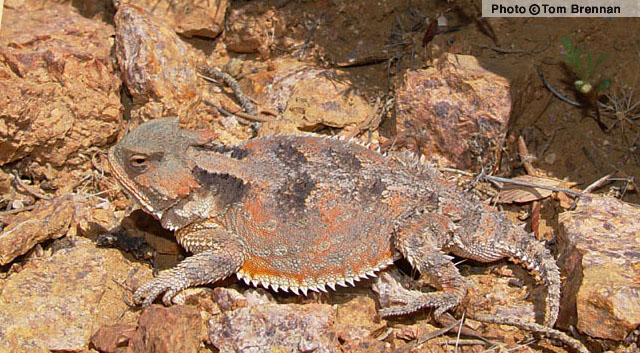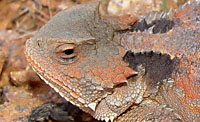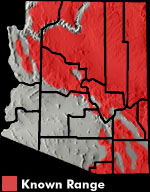Online Field Guide to The Reptiles and Amphibians of Arizona



Gila County, AZ
 Gila Co., AZ |
| GREATER SHORT-HORNED LIZARD Phrynosoma (Tapaja) hernandesi |
|
|
DESCRIPTION: A medium-sized (up to 125 mm or 4.9″ from snout to vent), exceptionally flat and wide lizard with short, stubby, horn-like scales projecting from the back of the head. A wide gap separates the bases of the two central horns. Several isolated, pointed scales project from the back. Each lower side of the body is edged with a single fringe of enlarged, pointed scales. Base coloration is tan, yellow-brown, orange-brown, reddish brown, or gray and usually matches the soil on which the animal lives. There are two large, dark blotches on the neck. The back is usually marked with a series of dark, irregular blotches or crossbars. The underside, particularly the chin, is often mottled with gray and the throat and chest may have tints of yellow-orange or reddish orange. The broad gap separating the two central horns of this lizard distinguishes it from other horned lizards in Arizona. DISTRIBUTION: Northern, central, and southeastern Arizona are home to this lizard. In our state it occurs at elevations ranging from about 4,000′ to over 11,000′. HABITAT: This cold tolerant lizard is found in a variety of biotic communities including Semidesert Grassland, Plains and Great Basin Grassland, our woodlands, Interior Chaparral, Petran Montane Conifer Forest, and Petran Subalpine Conifer Forest. It is often encountered in relatively open, sunlit areas within mountainous terrain, foothills, steep bajadas, and high, flat, shrubby plateaus. BEHAVIOR: The Greater Short-horned Lizard is a diurnal ground-dweller that is often encountered basking in the mid-morning sun. It hibernates during the cold months of winter and late fall. It occasionally squirts blood from its eyes when threatened or captured. This blood might have a foul taste designed to deter predators. Other defensive behaviors include inflating itself by gulping air and poking with the horns. DIET: Ants make up the bulk of this lizard’s diet but it also takes beetles, grasshoppers, and other insects. REPRODUCTION: Mating takes place in spring. A litter of up to 48 young is born in summer. Young are born in a clear amniotic sac from which they must break free in order to survive. By Thomas C. Brennan Brennan, T. C., and A. T. Holycross. 2006. A Field Guide to Amphibians and Reptiles in Arizona. Arizona Game and Fish Department. Phoenix, AZ Brennan, T. C., and A. T. Holycross. 2005. A Field Guide to Amphibians and Reptiles of Maricopa County. Arizona Game and Fish Department. Phoenix, AZ Stebbins, R.C. 2003. A Field Guide to Western Reptiles and Amphibians, Third Edition. Houghton Mifflin Company, Boston, MA. |
|
Visit Partners in Amphibian and Reptile Conservation:


HOME
Copyright © 2023, Arizona Game and Fish Department. All rights reserved.
If you make use of the textual contents of this site in reports, publications, etc. please cite and credit the author(s) and photographer(s). All photos on this website are copyrighted. However, those found in the species account section may be used for any noncommercial scientific, educational, or conservation purposes provided that photographs are not altered and continue to bear the copyright symbol and name of the photographer. Please contact the photographer regarding commercial use of copyrighted photographs.










